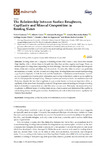Mostrar o rexistro simple do ítem
The Relationship between Surface Roughness, Capillarity and Mineral Composition in Roofing Slates
| dc.contributor.author | Cardenes, Víctor | |
| dc.contributor.author | García Martínez, Alberto | |
| dc.contributor.author | Rodríguez, Eduardo | |
| dc.contributor.author | Hernández Battez, Antolin | |
| dc.contributor.author | López Piñeiro, Santiago | |
| dc.contributor.author | Ruiz de Argandoña, Vicente | |
| dc.contributor.author | Rubio-Ordóñez, A. | |
| dc.date.accessioned | 2020-07-02T15:15:55Z | |
| dc.date.available | 2020-07-02T15:15:55Z | |
| dc.date.issued | 2020-06-15 | |
| dc.identifier.citation | Cardenes, V.; García, A.; Rodríguez, E.; Hernández Battez, A.; López-Piñeiro, S.; Ruiz de Argandoña, V.G.; Rubio-Ordoñez, Á. The Relationship between Surface Roughness, Capillarity and Mineral Composition in Roofing Slates. Minerals 2020, 10, 539. https://doi.org/10.3390/min10060539 | es_ES |
| dc.identifier.issn | 2075-163X | |
| dc.identifier.uri | http://hdl.handle.net/2183/25875 | |
| dc.description | Este artículo pertenece al número especial: "Minerals and Other Phases in Constructional Geomaterials". | es_ES |
| dc.description.abstract | [Abstract] Roofing slates are a category of building stones which have a very distinctive feature: High fissility, which allows them to be split into tiles that are thin, regular and large. There are several types of roofing slates, depending on their lithology. The four main lithologies are low-grade slates, slates stricto sensu, phyllites, and mica-schist. Occasionally, other rocks such as quartzites, serpentinites, or shales, can also be used as roofing slates. Roofing slates must ensure waterproofing, a quality that depends on both the rock and the installation. Installation must therefore take into account parameters such as the pitch, orientation, and overlap of the tiles in order to avoid capillarity, which could jeopardize waterproofing. These parameters are usually included in installation manuals. However, despite the fact that roughness is a parameter known to have an important e ect on capillarity, it has never been thoroughly analyzed. Roughness varies depending on the type of roofing slate, but installation manuals do not take this factor into account. This study has measured surface roughness in di erent types of roofing slates using a laser scanner and determined the capillarity values along and across the grain direction. Furthermore, the role of dissolved salts in capillarity has likewise been studied. | es_ES |
| dc.description.sponsorship | Víctor Cárdenes is grateful to his grant PA-18-ACB17-11, from the Program Marie-Curie COFUND funded by the European Union, Government of Asturias (Spain) and the Spanish FICYT | |
| dc.description.sponsorship | Principado de Asturias.Gobierno; PA-18-ACB17-11 | |
| dc.language.iso | eng | es_ES |
| dc.publisher | MDPI | es_ES |
| dc.relation.ispartofseries | 539 | es_ES |
| dc.relation.uri | http://dx.doi.org/10.3390/min10060539 | es_ES |
| dc.rights | Atribución 4.0 Internacional | es_ES |
| dc.rights.uri | http://creativecommons.org/licenses/by/4.0/ | * |
| dc.subject | Roofing slate | es_ES |
| dc.subject | Capillarity | es_ES |
| dc.subject | Salts | es_ES |
| dc.subject | Roof installation | es_ES |
| dc.subject | Surface roughness | es_ES |
| dc.title | The Relationship between Surface Roughness, Capillarity and Mineral Composition in Roofing Slates | es_ES |
| dc.type | info:eu-repo/semantics/article | es_ES |
| dc.rights.access | info:eu-repo/semantics/openAccess | es_ES |
| UDC.journalTitle | Minerals | es_ES |
| UDC.volume | 10 | es_ES |
| UDC.issue | 6 | es_ES |
| dc.identifier.doi | 10.3390/min10060539 |
Ficheiros no ítem
Este ítem aparece na(s) seguinte(s) colección(s)
-
II - Artigos [569]
-
OpenAIRE [341]






